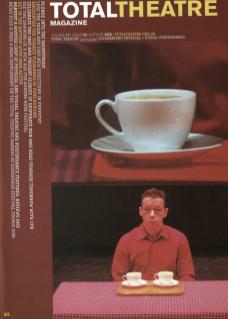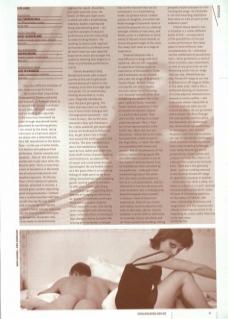The Firebird Ball (inspired by Shakespeare's Romeo and Juliet and Stravinsky's Firebird) starts in a cabaret bar. In two and threes we are taken off to be masked and let loose in the labyrinth. In the cavernous basement we roam through abandoned rooms populated by wandering ghosts. I am seized by the hand, led up staircases to a ballroom where I am drawn into a demented jive, then left abandoned on the dance floor – in the sea of white masks, it is hard to tell audience from performers. Further onwards and upwards... Narnia-like alternate worlds nest inside each other like Russian dolls. There is more than a hint of decadence in the heady mix of sensual experiences and masked voyeurism. On the top floor is Friar Lawrence's gloomy domain, drenched in incense, a stained glass window separating pews and gravestones. I venture into a confessional box and find myself sharing the tiny space with a terrifying Lord Capulet.
Juliet's father and her supposed ally the Friar are both portrayed as dangerous characters who, consciously or unconsciously, engineer her death. Elsewhere, in a stark concrete room, the death-of-Mercutio fight scene is acted out with a breathtaking intensity, bodies crashing and flying and slamming down – it's a perfect example of physical performance and site interacting to make thrilling theatre. The masking (a device used regularly by Punchdrunk) is a brilliant move. We each retain our own separate experiences and it discourages the audience chatting that happens so often at promenade performance events.
Frantic Assembly's Dirty Wonderland starts with a coach journey to the site (a gloriously wasted beauty of a hotel) in the company of an Alan Partridge type tour guide. It's an unnecessary framing device that is, in any case, illogically abandoned once the piece gets going. The lobby opening scene is a creaky mix of naturalistic dialogue and choreographed movement – and I start to worry. But as the main characters (boy-girl checking in for a dirty weekend) get separated and we are beckoned to follow the boy, we get drawn into a hectic race around the building that is full of thrills. The dirty weekend turns into a lost weekend as the boy is set upon by foxy ladies and drawn into hotel staff scenes of power-broking and humiliation, as explorations of sexual and social power become intermingled. We are herded around at a fair pace; there is a continuing feeling of slight panic as we hurry along, encountering room-swapping guests running naked in corridors lit with ultra-violet light, being squashed up against gyrating disco dancers or trudging up staircases as 'guests’ in underwear push past. There are any number of great visual moments: a sea-view dining room resplendent with shimmering neon-coloured jellies; a mannequin that changes clothes to match the missing girl's wardrobe; a hanged man on the stairwell that we are rushed past. In a breathtaking finale, we glimpse blood-soaked scenes of slaughter, encounter the Hotel manager's basement room in which the autocrat sits on a bed set amongst a forest of real trees, and finally arrive in a ballroom in which waves of dancers move towards us across the great length of the room. The shaky start ends as a magical experience.
Dreamthinkspeak take a very different strategy with their audience, who are left unguided to experience Underground, an exploration of Dostoevsky's Crime and Punishment set on, around and under the stage of Brighton's Theatre Royal. At first, I keep missing the set-piece scenes, but then cotton on to following one character around rather then wandering the theatre like a lost soul. I pick on Sonia, innocent flower-turned-prostitute. I first encounter her parasol, placed in a dark bricked corner. Then she's on film, waiting on a street under the parasol. Next, I find her in live representation in the (real) bar. When she runs out distressed, I follow her to her room, furnished with a little shrine to the Virgin Mary, in which she sobs uncontrollably with shame and despair. One of the pleasures of the piece is encountering spaces like this little room (created in one of the theatre's balcony boxes) first as installations then animated by the performer – although I have mixed feelings about the power this site exerts on the audience, full as it is of associations, and am interested to see how the piece will work elsewhere. But in Underground, dreamthinkspeak have created a treasure-trove of theatrical experiences; films of city streets and railway tunnels projected onto walls or doorways; ghosts outside windows; a mirror with no reflection; an ensemble chorus who flock and de-flock around the building, sitting grouped around suitcases or criss-crossing the stage. So ultimately a rich and rewarding experience that relies on a bit of work on the audience's part!
Station House Opera's Live in Paradise is a rather different kettle of fish – an exploration of the possibilities of live and screen performance that takes place in three different sites simultaneously. So – and check out the mathematical possibilities here – three performers in each of three locations, plus cameraman, so that at any given time we are witnessing action live on-stage from our site, filmed from our site, filmed off-stage at our site, or filmed on or off stage at either of the other sites. Add to this deliberate blurring of characters of similar physical characteristics dressed in similar outfits – and it becomes almost impossible at times to work out what you are witnessing where. We are presented with a dream-like Alice Through the Looking Glass world in which the characters are deliberately two-dimensional representations of stereotypes, their actions ritualistic and their conversations cut-ups of naturalistic exchanges. Small domestic incidences morph into a more troubling (although never really disturbing) mix of provocations, sexual games and cartoon violence. The effect is of a Buñuel film scripted by Gertrude Stein. There are a few gimmicky ideas – such as clothing removed in one location tossed off-stage to apparently reappear in another – which wear thin after a while, but taken as a whole it is a well-realised and provocative piece which raises all sorts of interesting questions on the nature of reality, the interrelationship of memory and imagination, and the response one affords something perceived to be happening on screen rather than live in the next room.

